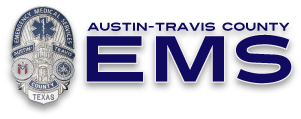Our Clinical Performance Indicators are a set of measures defined by the Office of the Medical Director that they and we use to measure system performance. Some of these measures are posted in other areas, as well. They are presented here as a group for easy reference.
These indicators are measured on a quarterly basis due to generally small monthly patient counts.
CPI 1: Trauma Scene Time

Definition
Scene time is the interval between the time that ATCEMS arrives at the patient’s location and the time that the ambulance begins transport of the patient. Our goal is 15 minutes or less 90% of the time. This data does not include incidents where scene delay is beyond the control of the Medics. One example is a prolonged rescue situation such as removing someone who is trapped in a crashed vehicle.
Why Is This Important?
Prehospital care providers have a limited ability to assess and treat trauma patients. The seriously injured often require rapid surgical intervention. Limiting scene time and rapidly transporting these patients to trauma centers allows them to receive definitive care sooner.
Click here for more information about this measure
CPI 2: Stroke Alert Scene Time

Definition
Scene time is the interval between the time that ATCEMS arrives at the patient’s location and the time that the ambulance begins transport of the patient. The Stroke Scene Time goal is 15 minutes or less 90% of the time. This data does not include incidents where scene delay is beyond the control of the medics, such as difficulty locating and accessing the patient.
Why Is This Important?
These patients require rapid assessment and treatment at a hospital that has the equipment and personnel necessary to provide definitive care. It is vital that we quickly identify strokes as quickly as possible, and provide rapid care and transport in order to expedite their treatment, thereby improving their outcomes. This measure shows our compliance with that goal.
Click here for more information about this measure
CPI 3: STEMI Scene Time

Definition
Scene time is the interval between the time that ATCEMS arrives at the patient’s location and the time that the ambulance begins transport of the patient. To be included in this measure, EMS medics must identify an S-T Segment Elevation Myocardial Infarction. The STEMI scene time goal is 15 minutes or less 90% of the time. This data does not include incidents where scene delay is beyond the control of the medics, such as difficulty accessing the patient.
Why Is This Important?
These patients require rapid treatment at a hospital that has the equipment and personnel necessary to provide definitive care. It is vital that we quickly identify STEMIs and provide rapid care and transport in order to expedite their treatment, thereby improving their outcomes. This measure shows our compliance with that goal.
Click here for more information about this measure
CPI 4: ACS Aspirin Administration

Definition
This is the percentage of patients assessed by EMS providers that present with Acute Coronary Syndrome (ACS) that receive aspirin. This measure excludes patients who may have medical reasons that prohibit aspirin administration such as an allergy to the medication.
Why Is This Important?
Research has shown that early aspirin administration is beneficial in patients with Acute Coronary Syndrome (ACS). The American Heart Association (AHA) recommends early administration of aspirin by appropriately trained providers, including Communication Medics (instructions are given by phone).
Click here for more information about this measure
CPI 5: Blood Glucose Testing for Altered Mental Status
[Chart pending]
Definition
This is the percentage of patients exhibiting signs and symptoms of altered mental status who receive a blood glucose assessment by EMS. Our goal is to assess the blood sugar level of 100% of these patients.
Why Is This Important?
Hypoglycemia, or low blood sugar, often presents with altered mental status. Fortunately, a simple blood test can assess for this condition. This is important because hypoglycemia can be easily reversed in the field; those patients may not event require or desire transport to a hospital.
Click here for more information about this measure
CPI 6: Blood Glucose Testing for Seizure
[Chart pending]
Definition
This is the percentage of patients who have had a seizure that receive a blood glucose assessment by EMS. Our goal is to assess the blood sugar level of 100% of these patients.
Why Is This Important?
Hypoglycemia, or low blood sugar, may present with a seizure, particularly in its later stages. Fortunately, a simple blood test can assess for this condition. This is important because hypoglycemia can be easily reversed in the field; those patients may not event require or desire transport to a hospital.
Click here for more information about this measure
CPI 7: Blood Glucose Testing in Stroke

Definition
This is the percentage of patients exhibiting signs and symptoms of a stroke who receive a blood glucose assessment by EMS. Our goal is to assess the blood sugar level of 100% of patients with signs and symptoms of a stroke.
Why Is This Important?
Hypoglycemia, or low blood sugar, easily can be mistaken for a stroke since both conditions can present with confusion and weakness. Fortunately, a simple blood test can distinguish between the two conditions. This is important because hypoglycemia can be easily reversed in the field; those patients may not event require or desire transport to a hospital.
Click here for more information about this measure

